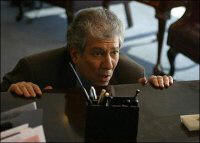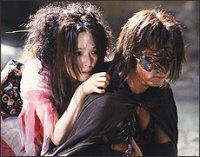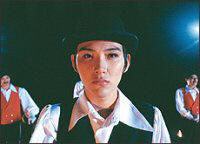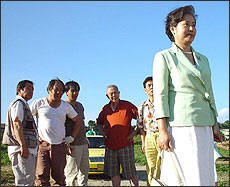14th Annual Philadelphia Film Festival
By Rich Drees
 King Of The
Corner (USA)
King Of The
Corner (USA)
Leo Spivak (Peter Riegert) is a guy who tries to play by the rules, but feels that he may be playing a different game all together. Leo seems to be facing a variety of mid-life crisises all at once- His career as a New York City advertising researcher has stalled, his marriage is more habit than relationship, he has virtually no connection with his daughter and he feels obligated to fly out to Arizona every weekend to visit his ailing father. What makes this film work is that the script gives the actors room to create some fine performances- from Eli Wallach as Leo’s cantankerous father to Eric Bogosian’s fast talking rabbi who gives a hilariously inappropriate eulogy to the subtle work done by Rita Moreno and Isabella Rossellini. Riegert himself gives an astounding performance, never drifting into Willie Lohman-esque territory with Leo. The film’s tone slides back and forth between comic and dramatic, but Riegert as director keeps the transitions smooth, never letting things get to slapstick or melodramatic, a fine balancing act that delivers a fine film.
One Missed Call/Izo (Japan)
This year’s festival contains two films from visionary Japanese director Takashi Miike, and for the most part, they could not be further polar extremes.
 One Missed Call
is Miike’s entry into the ongoing cycle of ghost/horror films that
started with Ringu (The Ring), Ju-On (The
Grudge) and Dark Water- all films that have since been
remade by Hollywood studios for American audiences too lazy to read
subtitles. It is hard to imagine, though, an Americanization of
One Missed Call, as the usually product placement-happy
Hollywood studios would be hard pressed to find a cell phone company
willing to lend its name to the film. After receiving mysterious
voicemail messages on their cell phones, several of Yumi’s
friends meet with bizarre and gruesome deaths. Investigating, Yumi
uncovers the standard culprit one has come to expect from a film of
this type- a creepy, spectral child with a face partially obscured
by their hair, abused in life and now seeking closure/revenge on the
living. At this point, the current wave of horror films coming out
of Japan is starting to feel played out, but Miike still manages to
extract a few chills and scares from something as decidedly
non-creepy as a cell phone while at the same time managing to
playfully tweak many of the genre’s conventions. However, one giant
red herring tin the film’s third act, a few too many endings and an
exasperatingly vague final scene make it hard to recommend One
Missed Call to anyone but Miike-devotees or diehard fans of
Japanese horror.
One Missed Call
is Miike’s entry into the ongoing cycle of ghost/horror films that
started with Ringu (The Ring), Ju-On (The
Grudge) and Dark Water- all films that have since been
remade by Hollywood studios for American audiences too lazy to read
subtitles. It is hard to imagine, though, an Americanization of
One Missed Call, as the usually product placement-happy
Hollywood studios would be hard pressed to find a cell phone company
willing to lend its name to the film. After receiving mysterious
voicemail messages on their cell phones, several of Yumi’s
friends meet with bizarre and gruesome deaths. Investigating, Yumi
uncovers the standard culprit one has come to expect from a film of
this type- a creepy, spectral child with a face partially obscured
by their hair, abused in life and now seeking closure/revenge on the
living. At this point, the current wave of horror films coming out
of Japan is starting to feel played out, but Miike still manages to
extract a few chills and scares from something as decidedly
non-creepy as a cell phone while at the same time managing to
playfully tweak many of the genre’s conventions. However, one giant
red herring tin the film’s third act, a few too many endings and an
exasperatingly vague final scene make it hard to recommend One
Missed Call to anyone but Miike-devotees or diehard fans of
Japanese horror.
 As linear and commercial One Missed Call is, Miike’s Izo
is not. Izo is much more an art film, as much as a movie
about a vengeful, time-traveling samurai can be, at any rate. The
film shifts temporal settings at whim, making Kurt Vonnegut’s
“unstuck-in-time” hero of Slaughterhouse-5 seem like a fly
trapped in amber by comparison. The film is a mishmash of imagery
from the hyper-real colors of a flowery meadow to the absurdity of
Izo being chased through downtown Tokyo by a cadre of feudal palace
guards. The fight scenes are brutal affairs, with the use of
hand-held cameras placing the audience in the middle of the mayhem.
There is some talk of karma and reincarnation, so I surmise that
possessing more than a rudimentary knowledge of Buddhist philosophy
could enhance one’s enjoyment of the film. If not, the best you can
hope do is to sit back and enjoy the unique visuals Izo has
to offer.
As linear and commercial One Missed Call is, Miike’s Izo
is not. Izo is much more an art film, as much as a movie
about a vengeful, time-traveling samurai can be, at any rate. The
film shifts temporal settings at whim, making Kurt Vonnegut’s
“unstuck-in-time” hero of Slaughterhouse-5 seem like a fly
trapped in amber by comparison. The film is a mishmash of imagery
from the hyper-real colors of a flowery meadow to the absurdity of
Izo being chased through downtown Tokyo by a cadre of feudal palace
guards. The fight scenes are brutal affairs, with the use of
hand-held cameras placing the audience in the middle of the mayhem.
There is some talk of karma and reincarnation, so I surmise that
possessing more than a rudimentary knowledge of Buddhist philosophy
could enhance one’s enjoyment of the film. If not, the best you can
hope do is to sit back and enjoy the unique visuals Izo has
to offer.
 Karaoke Terror
(Japan)
Karaoke Terror
(Japan)
Let’s face it: A name like Karaoke Terror is bound to make one stop paging through the festival program and read a bit further. But don’t go into this film expecting some kitschy comedy about office workers who sing off key. Instead, Karaoke Terror is a dark social satire, pitting a group of teenage boys against a group of thirty-something divorced women. When one youth‘s clumbsy pick-up attempt is rejected, he impulsively kills the older woman, slashing her throat in a moment of savage intensity. When her friends discover who the killer is, they extract revenge. Soon, the two groups are locked in a war of vengeance that escalates to a climax which while absurd, still feels as realistically reached as can be expected. The moments of violence are few but pack a visceral wallop. The screenplay, at times almost gleeful in its amorality, draws interesting parallels between the two groups until, by the time the film reaches its fiery climax, you are sympathizing with both sides of the conflict.
Macked, Hammered, Slaughtered And Shafted (USA)
While there have been documentaries that have charted the history of the 1970s blaxploitation genre, until now, none have really placed the films into the broader context of the civil rights movement and the societal landscape of the decade. Director David Walker provides such a context through interviews with many of the major talents from both in front of and behind the camera, many of whom commenting with hitherto unseen candor. What becomes apparent is that the blaxploitation boom came about through a “perfect storm” conjunction of factors, not the least of which include the low production cost of films like Shaft or The Mack compared to the amount they drew at the box office, various studios’ financial instability and how audiences felt empowered by seeing characters that they could relate to on screen. Hell Up In Harlem and Black Caesar (both 1973) director Larry Cohen even goes so far as to compare the craze to the Warner Brothers Studio’s cycle of gangster films from the 1930s. But while most interviewees could agree that films like Superfly (1972) definitely influenced clothing styles amongst its audience, they often disagreed on various other subjects ranging from whether or not the black actors and crew people were being exploited by the film studios to the validity of criticisms charged at the genre for its levels of violence.
 Sweet Sixties
(Korea)
Sweet Sixties
(Korea)
In its opening moments, in which an ostrich calmly runs by an elderly and startled motor-scooter rider, Sweet Sixties suggests that it is going to be a quirky comedy, but it is not. Instead, it is a light-hearted, character-driven comedy about four older male residents of a rural Korean village whose lives are turned upside down when an attractive and mysterious older woman comes to town. The plot is whisker thin, but the film delivers with its characters, be it the ostrich farmer and his bickering neighbor or the tentative romance between the bachelor in his mid-50s and the twenty-something owner of the local cafe. All feel true without having the types of quirks Hollywood screenwriters frequently like to graft onto such character types. If it weren’t for the fact that the characters are speaking Korean, one could very easily imagine encountering these types of folks in one’s own neighborhood. Sweet Sixties is a remarkable showcase for its actors, who deliver some fine and heartwarming performances.
 Cutie Honey
(Japan)
Cutie Honey
(Japan)
Based on a popular Japanese comic book turned animae, Cutie Honey is probably the most outrageous and audacious film to be screened this year. Hideaki Anno, who worked as both an animator and director on several Japanese animae series, succeeds in translating the cartoony style to live-action film, retaining the original’s kinetic spirit. Cutie Honey is a cyborg who can transform from bubbly office worker to an equally effervescent superhero who fights the machinations of the nigh immortal “Sister Jill” and her minions in the Panther Claw clan. Dialogue like, “I’ll walk. Investigation is based on legwork!” – delivered by Cutie Honey to a potential ally – demonstrates that the movie has no intentions of taking itself too seriously. Fortunately, it never reaches for any level of post-modern irony or camp, which would only diminish the proceedings. Cutie Honey is pure cinematic popcorn, served in a big bucket with a highly caffeinated drink to wash it down.